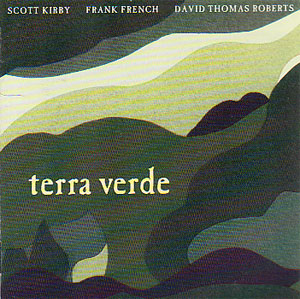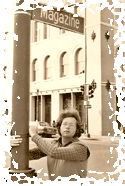Terra Verde

(with Scott Kirby and Frank French, Viridiana, Sandpoint, ID, 1996 - CD)
Status: Available at CD Baby
Track Listing & Liner Notes (for DTR-played pieces*):
*(The Big Man by Tom McDermott, dedicated to DTR and played by Scott Kirby is also included.)
- Chandelier Rag (By Hal Isbitz, Pianist Scott Kirby)
- To Nita (By David Thomas Roberts, 1994-1994, for Agneta Dupen, Pianist David Thomas Roberts). Commissioned by a husband as a surprise for his wife, this piece grew out of my friendship with Jack and Nita Dupen of Tiberon California. Begun in Littleton Colorado, it was primarily composed in Mississippi and Missouri. Like many Terra Verde compositions, it reflects roughly equal affinities for Romanticism, ragtime, and various Latin materials. The influence of Brazilian tango master Ernesto Nazareth (1863-1934) is evident in the third section. A cadenza-like area dominates the coda, reinforcing the generally extroverted, exuberant character of To Nita (recorded 9/14/96).
- Sosua (By Glenn Jenks, Pianist Frank French)
- Womba Bomba (By Frank French, Pianist Frank French)
- Revenge (from New Orleans Streets) (By David Thomas Roberts, 1983, Pianist David Thomas Roberts). New Orleans Streets (1981-1985) is a brooding, eclectic suite of fifteen pieces affected by Romanticism, ragtime, Latin American (and especially Caribbean) music, Classic Jazz, early rock and roll, hymns, country music, and Mediterranean material. Though most of what became “Introduction” predated other contents, the conception of a suite of streets originated with "Revenge" which was born on a night of well-tuned rage as I paced the streets of uptown New Orleans, especially the Carrollton area. The Chopin Nocturnes helped shape the first theme, whereas country music has left its mark on the trio, yielding an effect intentionally both heartfelt and ironic. (Recorded 9/12/96)
- Miranda (By Hal Isbitz, Pianist Frank French)
- Intermezzo (By Frank French, Pianist Scott Kirby)
- North Star (By Brian Keenan, 1994-1995, for Maria Kistner, Pianist David Thomas Roberts). Brian Keenan (b.1971), a native of St. Paul, Minnesota came to the attention of regime enthusiasts in Colorado in 1991 while he was studying piano and composition at the University of Colorado in Boulder. Having written rags since age twelve, he had already discovered much of the basis of his ragtime language. Since the early nineties he has established himself as one of New Ragtime's central figures with such works as Mississippi River Boulevard,
Colorado Panorama, Over The Lake Street Bridge, and For Joani Holmes. His first CD, Solo Piano, appeared on Solo Art in 1996.
North Star (the title is a reference to Minnesota) was his first unarguable expression of Terra Verde. Though evincing traces of early ragtime (i.e., the tritones resolving to thirds in the first strain), this lyrical work is demonstrative of the absorption of recent popular music traits, a phenomenon figuring in a fair number of Terra Verde and New Ragtime compositions. The discreet influence of late sixties and early seventies rock is partly responsible for North Star’s eluding a Latinesque personality despite its continuous employment of an habanera bass. The remarkable second section (marked “pathetic”) is spiced with vernacular dissonances straight out of pop singers' parlance and a cadence sporting a melodic surprise distantly reminiscent of Ferdinand “Jelly Roll” Morton's most elegant ideas. The trio (marked "ethereal") gains some pop associations through its E flat to D flat progression (while the former briefly serves as the tonal center). For me, the most moving passage in North Star is the last phrase of this strain, an affectionate outburst as convincing as anything in Keenan's output. The finale is the section most infused with the personality of late sixties pop and perhaps the most rarefied music yet written to be so transparent in the affiliation. (recorded 9/13/96). - Lone Jack to Knob Noster (By Jack Rummel, Pianist Frank French)
- Waltz (By Scott Kirby, Pianist Scott Kirby)
- One The Trail of the Conestoga Wagons (By Frank French, Pianist Frank French)
- Raúl Casso in Laredo (By David Thomas Roberts, 1995-1996, for Raúl Casso, Pianist David Thomas Roberts). Long-time enthusiast of Classic Ragtime Raúl Casso learned of the flourishing of contemporary ragtime composition when he met Scott Kirby in New Orleans in 1993. Shortly afterwards he wrote me and ordered recordings and sheet music which prompted an ongoing series of exchanges. In 1995 he commissioned a work reflecting his Romantic affinities and tendency toward darker moods, a specification that pleased and motivated me. Casso was born and raised in the border town of Laredo. When he first contacted me he had no idea that I had worked there in the spring of 1989 and carried my own charged impressions of the area. His self-description, revelations about his relationship with Laredo and my idiosyncratic links to the town fostered the mindset leading directly to the bleak first strain in B flat minor.
Raúl Casso in Laredo is a thoroughly Romantic essay in which rag-like sections alternate with those utilizing Latin bass patterns (including both habanera-derived and tango-like elements). It is a dramatic piece in which the lyrical, cantabile trio's connections to the theatrical fourth section are central. An interlude based on the fourth strain's opening phrase prepares the return of the first theme, which is followed by a coda reflecting the still-viable influence of Chopin. (recorded 9/15/96 and 9/16/96). - Nocturne in C# Minor (By Scott Kirby, 1994, for Marie-Dominique Verdier, Pianist David Thomas Roberts). The music of Scoff Kirby is at the very heart of Terra Verde's identity. No composer working in New World piano forms has embarked upon more haunting and challenging journeys inward, and the Nocturne in C# Minor remains one of Kirby's most touching and masterful revelations.
The form, AA1 BB1 A2 INTERLUDE CC1 DD1 E D2D3 E1 CODA, not only offers a stark separation of rag-like and habanera bass ostinati (the latter takes over at the interlude) but emphasizes the habanera as a vehicle to interiority, of somnambulant movement, of rocking descent into memory and meaning. From the outset the listener realizes this is rarefied territory, a pensive, fragile domain in which detail is as crucial as in dreams. The turn signaled by the interlude is a very dark one, sparing nothing as it sways through floridly gothic associations in the C and D sections. But it is the E that tells where all must lead. Its first phrase is a variation of the D's opening, the difference amounting mainly to transposition from B flat minor to B flat major. Yet a different realm has been entered, a setting for final realizations through which some ultimate lyrical utterance is possible. In performance I approach this section with a sense of preciosity reserved for few passages in my repertory. The interpretive effect overlapping bars 4-5 of the E is the composer’s own idea, which he refers to as "a gasp." The consoling coda which, like much of the piece, grows out of the opening bars, derives considerable content from the E, ideally rounding out a work that draws much of its poignance from motivic regeneration and quotation uncommon in strophic compositions. (recorded 9/16/96). - The Big Man (By Tom McDermott, 1990, for David Thomas Roberts, Pianist Scott Kirby). Dedicated to David Thomas Roberts, The Big Man comes from the mind of Tom McDermott, and upon hearing the first few bars it becomes evident that this work could not have originated in any other musical imagination. McDermott's impressive body of composition covers more textural territory than most writers traverse in a lifetime, yet his unmistakable voice seems to steer through this eclectic sea in exciting and unexpected ways. For example, The Big Man employs an eerie melodic line which twists, turns and creeps in and out of the shadows created by the underlying harmonies and the understated habanera bass line. Significantly, although the habanera serves as the ostinato throughout, there is nothing Latin-American about the melody, harmony or the general mood (as opposed to some examples of Terra Verde utilizing similar rhythmic foundations.) The Big Man, therefore, in achieving an identity which (though it may draw from) is separate from ragtime and various Latin-American styles, offers a clue to understanding what lies at the center of this genre, at the heart of Terra Verde. (recorded 9/11/96)
- Recovery Part 1 (From The Journey Home) (By Scott Kirby, Pianist Scott Kirby)
- Recovery Part 2 (From The Journey Home) (By Scott Kirby, Pianist Scott Kirby)

